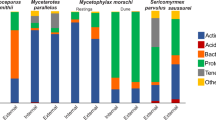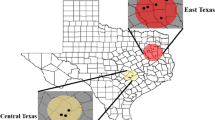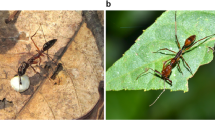Abstract
Fungus-growing ants share a complex symbiosis with microbes, including fungal mutualists, antibiotic-producing bacteria, and fungal pathogens. The bacterial communities associated with this symbiosis are poorly understood but likely play important roles in maintaining the health and function of fungal gardens. We studied bacterial communities in gardens of two Apterostigma species, A. dentigerum, and A. pilosum, using next-generation sequencing to evaluate differences between the two ant species, their veiled and no-veiled fungal garden types, and across three collection locations. We also compared different parts of nests to test for homogeneity within nests. Enterobacteriaceae dominated gardens of both species and common OTUs were shared across both species and nest types. However, differences in community diversity were detected between ant species, and in the communities of A. dentigerum veiled and no-veiled nests within sites. Apterostigma pilosum had a higher proportion of Phyllobacteriaceae and differed from A. dentigerum in the proportions of members of the order Clostridiales. Within A. dentigerum, nests with veiled and no-veiled fungus gardens had similar taxonomic profiles but differed in the relative abundance of some groups, with veiled gardens having more Rhodospirillaceae and Hyphomicrobiaceae, and no-veiled having more Xanthomonadaceae and certain genera in the Enterobacteriaceae C. However, bacterial communities in Apterostigma fungal gardens are highly conserved and resemble those of the nests of other attine ants with dominant taxa likely playing a role in biomass degradation and defense. Further work is required to understand and explain how bacterial community composition of fungus-growing nests is maintained.
Similar content being viewed by others
References
Andersen, S.B., Hansen, L.H., Sapountzis, P., Sørensen, S.J., and Boomsma, J.J. 2013. Specificity and stability of the Acromyrmex-Pseudonocardia symbiosis. Mol. Ecol. 22, 4307–4321.
Aylward, F.O., Burnum-Johnson, K.E., Scott, J.J., Suen, G., Tringe, S.G., Adams, S.M., Barry, K.W., Nicora, C.D., Piehowski, P.D., Purvine, S.P., et al. 2012. Metagenomic and metaproteomic insights into bacterial communities in leaf-cutter ant fungus gardens. ISME J. 6, 1688–1701.
Aylward, F.O., Suen, G., Biedermann, P.H.W., Adams, A.S., Scott, J.J., Malfatti, S.A., Glavina del Rio, T., Tringe, S.G., Poulsen, M., Raffa, K.F., et al. 2014. Convergent bacterial microbiota in the fungal agricultural systems of insects. mBio 5, e02007–14.
Belt, T. 1874. The Naturalist in Nicaragua, pp. 403. University of Chicago Press, Chicago, USA.
Benemann, J.R., Berenson, J.A., Kaplan, N.O., and Kamen, M.D. 1973. Hydrogen evolution by a chloroplast-ferredoxin-hydrogenase system. Proc. Natl. Acad. Sci. USA 70, 2317–2320.
Cafaro, M.J. and Currie, C.R. 2005. Phylogenetic analysis of mutualistic filamentous bacteria associated with fungus-growing ants. Can. J. Microbiol. 446, 441–446.
Caporaso, J.G., Kuczynski, J., Stombaugh, J., Bittinger, K., Bushman, F.D., Costello, E.K., Fierer, N., Gonzalez Pena, A., Goodrich, J.K., Gordon, J.I., et al. 2010. QIIME allows analysis of high-throughput community sequencing data. Nat. Methods 7, 335–336.
Chapela, I.H., Rehner, S.A., Schultz, T.R., and Mueller, U.G. 1994. Evolutionary history of the symbiosis between fungus-growing ants and their fungi. Science 266, 1691–1694.
Currie, C.R., Mueller, U.G., and Malloch, D. 1999. The agricultural pathology of ant fungus gardens. Proc. Natl. Acad. Sci. USA 96, 7998–8002.
Currie, C.R., Wong, B., Stuart, A.E., Schultz, T.R., Rehner, S.A., Mueller, U.G., Sung, G.H., Spatafora, J.W., and Straus, N.A. 2003. Ancient tripartite coevolution in the attine ant-microbe symbiosis. Science 299, 386–388.
Dentinger, B.T.M., Jean Lodge, D., Munkacsi, A.B., Desjardin, D.E., and McLaughlin, D.J. 2009. Phylogenetic placement of an unusual coral mushroom challenges the classic hypothesis of strict coevolution in the Apterostigma pilosum group ant-fungus mutualism. Evolution 63, 2172–2178.
Fernández-Marín, H., Zimmerman, J.K., and Wcislo, W.T. 2003. Nest-founding in Acromyrmex octospinosus (Hymenoptera, Formicidae, Attini): demography and putative prophylactic behaviors. Insect. Soc. 50, 304–308.
Fernández-Marín, H., Zimmerman, J.K., and Wcislo, W.T. 2004. Ecological traits and evolutionary sequence of nest establishment in fungus-growing ants (Hymenoptera, Formicidae, Attini). Biol. J. Linn. Soc. 81, 39–48.
Fernández-Marín, H., Zimmerman, J.K., and Wcislo, W.T. 2007. Fungus garden platforms improve hygiene during nest establisment in Acromyrmex ants (Hymenoptera, Formicidae, Attini). Insect. Soc. 54, 64–69.
Folmer, O., Black, M., Hoeh, W., Lutz, R., and Vrijenhoek, R. 1994. DNA primers for amplification of mitochondrial cytochrome c oxidase subunit I from diverse metazoan invertebrates. Mol. Marine Biol. Biotechnol. 3, 294–299.
Gerardo, N.M., Mueller, U.G., and Currie, C.R. 2006. Complex host-pathogen coevolution in the Apterostigma fungus-growing ant-microbe symbiosis. BMC Evol. Biol. 6, 88.
González, C.T., Wcislo, W.T., Cambra, R., Wheeler, T.A., and Fernández-Marín, H. 2016. A new ectoparasitoid species of Pseudogaurax Malloch, 1915 (Diptera: Chloropidae), attacking the fungus-growing ant, Apterostigma dentigerum Wheeler, 1925 (Hymenoptera: Formicidae). Ann. Entomol. Soc. Am. 109, 629–638.
Hanshew, A.S., Mason, C.J., Raffa, K.F., and Currie, C.R. 2013. Minimization of chloroplast contamination in 16S rRNA gene pyrosequencing of insect herbivore bacterial communities. J. Microbiol. Methods 95, 149–155.
Hölldobler, B. and Wilson, E. 1990. The ants, pp. 732. Harvard University Press, Cambridge, UK.
Ishak, H.D., Miller, J.L., Sen, R., Dowd, S.E., Meyer, E., and Mueller, U.G. 2011. Microbiomes of ant castes implicate new microbial roles in the fungus-growing ant Trachymyrmex septentrionalis. Sci. Rep. 1, 204.
Kellner, K., Ishak, H.D., Linksvayer, T.A., and Mueller, U.G. 2015. Bacterial community composition and diversity in an ancestral ant fungus symbiosis. FEMS Microbiol. Ecol. 91, fiv073.
Kembel, S.W., O’Connor, T.K., Arnold, H.K., Hubbell, S.P., Wright, S.J., and Green, J.L. 2014. Relationships between phyllosphere bacterial communities and plant functional traits in a neotropical forest. Proc. Natl. Acad. Sci. USA 111, 13715–13720.
Klett, F.P., Burlinson, P., Deveau, A., Barret, M., Tarkka, M., and Sarniguet, A. 2011. Bacterial-fungal interactions: hyphens between agricultural, clinical, environmental, and food microbiologists. Microbiol. Mol. Biol. Rev. 75, 583–609.
Lattke, J.E. 1997. Revisión del género Apterostigma Mayr (Hymenoptera: Formicidae). Arq Zool (São Paulo) 34, 121–221.
Lattke, J.E. 1999. A new species of fungus-growing ant and its implications for attine phylogeny. Syst. Entomol. 24, 1–6.
Little, A.E.F., Murakami, T., Mueller, U.G., and Currie, C.R. 2006. Defending against parasites: fungus-growing ants combine specialized behaviours and microbial symbionts to protect their fungus gardens. Biol. Lett. 2, 12–16.
McDonald, D., Price, M.N., Goodrich, J., Nawrocki, E.P., DeSantis, T.Z., Probst, A., Andersen, G.L., Knight, R., and Hugenholtz, P. 2012. An improved greengenes taxonomy with explicit ranks for ecological and evolutionary analyses of bacteria and archaea. ISME J. 6, 610–618.
Mehdiabadi, N.J., Mueller, U.G., Brady, S.G., Himler, A.G., and Schultz, T.R. 2012. Symbiont fidelity and the origin of species in fungus-growing ants. Nat. Commun. 3, 840.
Mehdiabadi, N.J. and Schultz, T. 2010. Natural history and phylogeny of the fungus-farming ants (Hymenoptera: Formicidae: Myrmicinae: Attini). Myrmecol. News 13, 37–55.
Meirelles, L.A., McFrederick, Q.S., Rodrigues, A., Mantovani, J.D., de Melo Rodovalho, C., Ferreira, H., Bacci, M., and Mueller, U.G. 2016. Bacterial microbiomes from vertically transmitted fungal inocula of the leaf-cutting Atta texana. Environ. Microbiol. Rep. 8, 630–640.
Mikheyev, A.S., Mueller, U.G., and Abbot, P. 2010. Comparative dating of attine ant and lepiotaceous cultivar phylogenies reveals coevolutionary synchrony and discord. Am. Nat. 175, 126–133.
Mikheyev, A.S., Mueller, U.G., and Boomsma, J.J. 2007. Population genetic signatures of diffuse coevolution between leaf-cutting ants and their cultivar fungi. Mol. Ecol. 16, 209–216.
Mikheyev, A.S., Vo, T., and Mueller, U.G. 2008. Phylogeography of post-Pleistocene population expansion in a fungus-gardening ant and its microbial mutualists. Mol. Ecol. 17, 4480–4488.
Morelos-Juárez, C., Thomas, W., Lopes, J.F.S., and Hughes, W. 2010. Ant farmers practice proactive personal hygiene to protect their fungus crop. Curr. Biol. 13, 553–554.
Mueller, U.G., Dash, D., Rabeling, C., and Rodrigues, A. 2008. Coevolution between attine ants and actinomycete bacteria: a reevaluation. Evolution 62, 2894–2912.
Munkacsi, B., Pan, J.J., Villesen, P., Mueller, U.G., Blackwell, M., and McLaughlin, D.J. 2004. Convergent coevolution in the domestication of coral mushrooms by fungus-growing ants. Proc. R Soc. Lond. B 271, 1777–1782.
Oh, D.C., Poulsen, M., Currie, C.R., and Clardy, J. 2009. Dentigerumycin: a bacterial mediator of an ant-fungus symbiosis. Nat. Chem. Biol. 5, 391–393.
Pinto-Tomás, A.A., Anderson, M.A., Suen, G., Stevenson, D.M., Chu, F.S.T., Cleland, W.W., Weimer, P.J., and Currie, C.R. 2009. Symbiotic nitrogen fixation in the fungus gardens of leaf-cutter ants. Science 326, 1120–1123.
Pitts-Singer, T.L. and Espelie, K.E. 2007. Nest demographics and foraging behavior of Apterostigma collare Emery (Hymenoptera, Formicidae) provide evidence of colony independence. Insect. Soc. 54, 310–318.
Poulsen, M., Erhardt, D.P., Molinaro, D.J., Lin, T.L., and Currie, C.R. 2007. Antagonistic bacterial interactions help shape host-symbiont within the fungus-growing ant-microbe mutualism. PLoS One 2, e960.
Samuels, R.I., Mattoso, C.T., and Moreira, D.D.O. 2013. Leaf-cutting ants defend themselves and their gardens against parasite attack by deploying antibiotic secreting bacteria. Commun. Integr. Biol. 6, e23095.
Santos, A.V., Dillon, R.J., Dillon, V.M., Reynolds, S.E., and Samuels, R.I. 2004. Ocurrence of the antibiotic producing bacterium Burkholderia sp. in colonies of the leaf-cutting ant Atta sexdens rubropilosa. FEMS Microbiol. Lett. 239, 319–323.
Schultz, T.R. 2007. The fungus-growing ants genus Apterostigma in dominican amber. Mem. Am. Entomol. Inst. 80, 425–436.
Schultz, T.R. and Brady, S.G. 2008. Major evolutionary transitions in ant agriculture. Proc. Natl. Acad. Sci. USA 105, 5435–5440.
Schultz, T.R., Sosa-Calvo, J., Brady, S.G., Lopes, C.T., Mueller, U.G., Bacci Jr, M., and Vasconcelos, H.L. 2015. The most relictual fungus-farming ant species cultivates the most recently evolved and highly domesticated fungal symbiont species. Am. Nat. 185, 693–703.
Scott, J.J., Budsberg, K.J., Suen, G., Wixon, D.L., Balser, T.C., and Currie, C.R. 2010. Microbial community structure of leaf-cutter ant fungus gardens and refuse dumps. PLoS One 5, e9922.
Sen, R., Ishak, H.D., Estrada, D., Down, S.E., Hong, E., and Mueller, U.G. 2009. Generalized antifungal activity and 454-screening of Pseudonocardia and Amycoltopsis bacteria in nests of fungus-growing ants. Proc. Natl. Acad. Sci. USA 10, 17805–17810.
Sosa-Calvo, J., Ješovnik, A., Lopes, C.T., Rodrigues, A., Rabeling, C., Bacci, Jr, M., Vasconcelos, H.L., and Schultz, T.R. 2017. Biology of the relict fungus-farming ant Apterostigma megacephala Lattke, including descriptions of the male, gyne, and larva. Insect. Soc. 64, 329–346.
Suen, G., Scott, J.J., Aylward, F.O., Adams, S.M., Tringe, S.G., Pinto-Tomás, A.A., Foster, C.E., Pauly, M., Weimer, P.J., Barry, K.W., et al. 2010. An insect herbivore microbiome with high plant biomass-degrading capacity. PLoS Genet. 6, e1001129.
Villesen, P., Mueller, U.G., Schultz, T.R., Adams, R.M.M., and Bouck, A.C. 2004. Evolution of ant-cultivar specialization and cultivar switching in Apterostigma fungus-growing ants. Evolution 58, 2252–2265.
Weber, N.A. 1966. Fungus-growing ants. Science 153, 587–604.
Weber, N.A. 1972. Gardening ants: the attines, pp. 146. American Philosophical Society, Philadelphia, USA.
Wheeler, W.M. 1925. Neotropical ants in the royal museum of Stockholm. Arkiv för Zoologi 178, 1–55.
Wilson, E.O. 1971. The insect societies, pp. 548. Belknap Press of Harvard, University Press, Cambridge, UK.
Woodhams, D.C. and Brucker, R.M. 2013. Disease defense through generations: leaf-cutter ants and their symbiotic bacteria. Mol. Ecol. 22, 4141–4143.
Acknowledgements
Thanks to two anonymous reviewers for their helpful comments which improved this manuscript. Thanks to Paola Galgani, Alvaro González, Christian Martin for field work, and to Evangelina López and Eyda Gómez for laboratory support in the MMUL at the Smithsonian Tropical Research Institute (STRI). Thanks to the Ministerio de Ambiente de Panama for collecting permits No. SE/AH-1-16. This research was funded by a scholarship from SENACYT, fellowship grant from STRI and SNI grant to CG, STRI general research funds to KS, and general research funds from Instituto de Investigaciones Científicas y Servicios de Alta Tecnología (INDICASAT AIP) and SNI grant to HF-M.
Author information
Authors and Affiliations
Corresponding authors
Additional information
Supplemental material for this article may be found at http://www.springerlink.com/content/120956.
Electronic Supplementary Material
Rights and permissions
About this article
Cite this article
González, C.T., Saltonstall, K. & Fernández-Marín, H. Garden microbiomes of Apterostigma dentigerum and Apterostigma pilosum fungus-growing ants (Hymenoptera: Formicidae). J Microbiol. 57, 842–851 (2019). https://doi.org/10.1007/s12275-019-8639-0
Received:
Revised:
Accepted:
Published:
Issue Date:
DOI: https://doi.org/10.1007/s12275-019-8639-0




